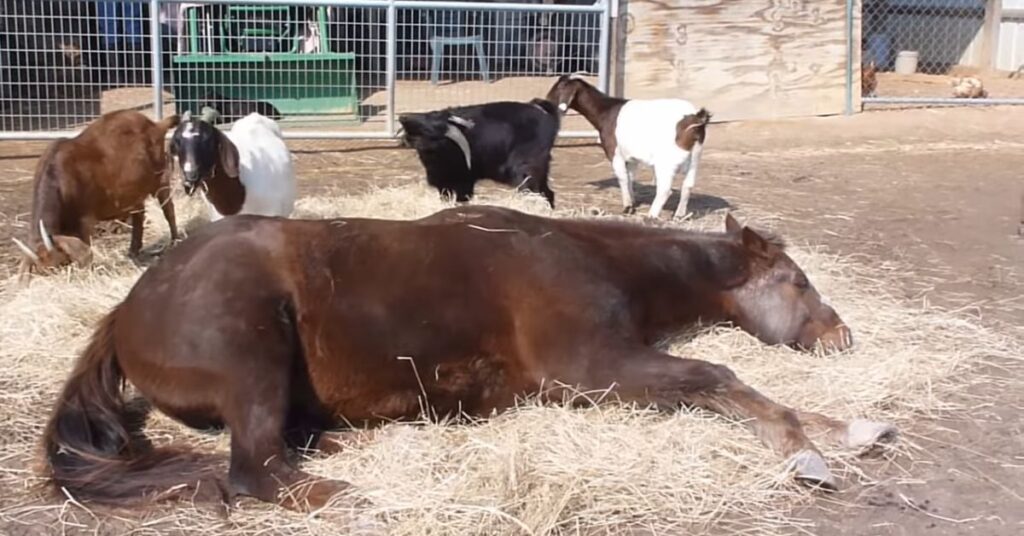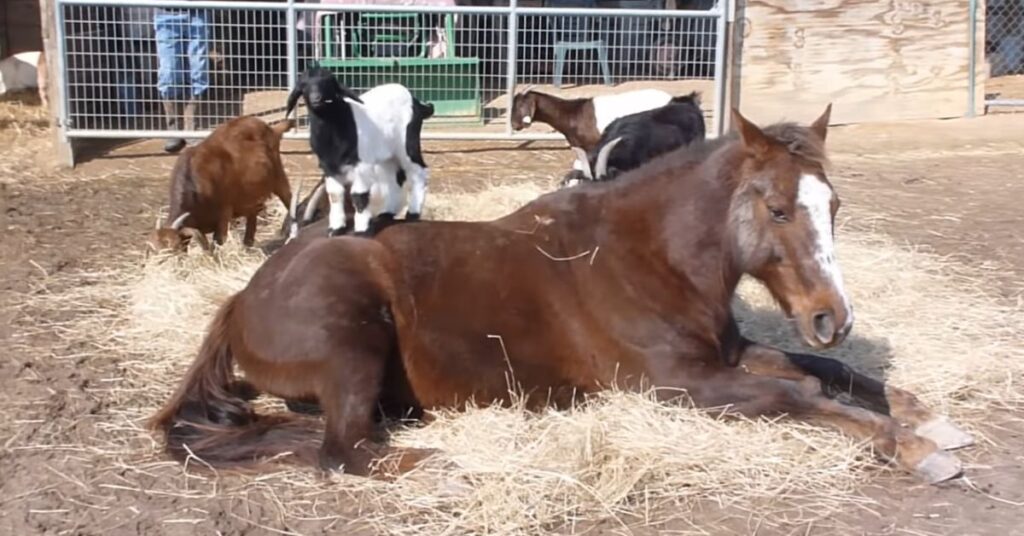As a longtime horse owner and recent goat parent, I’ve experienced firsthand the joys and challenges of integrating these two herd species. Like most animal owners, I want to provide the best care for all my creatures.
Goats need companionship and horses should never be alone. After much research and cautious experimentation, I’ve discovered goats and horses can not only coexist but actually form bonds, enriching each other’s lives.
With careful introduction and proper precautions, goats and horses can live together contentedly, offering social enrichment that benefits both species. However, considerations regarding animal temperament, size, feeding, and housing must be addressed to ensure a safe and harmonious environment.
Read on to learn from my experience about ideal pairings, proper introductions, safe feeding practices, and suitable housing for goats and horses together. With thoughtfulness and attentive management, interspecies friendships can flourish on your farm too!
Why Companionship is Key
Horses are pack animals by nature and therefore don’t do well in solitude. In fact, isolated horses can become distressed, depressed, anxious, and even aggressive or dangerous.
Equine companions provide critical socialization and soothing familiarity. And while another horse is the obvious choice, financially and spatially that’s not always feasible. This is where goats can be the perfect solution!
Goats are also highly social herd animals. They require companionship not just for mental well-being but to satisfy their curious and energetic personalities.
Goats generally enjoy investigating their environments. But without adequate stimulation and engagement, they become bored and destructive. Another goat is the easiest option for companionship but not the only one.
The Benefits of Inter-species Pairings

- Goats offer equine friendship without the expense of additional horses
- Two herd species can provide mutual social enrichment
- Goats help utilize and maintain pasture spaces
- Goats provide entertainment and interest for horse and human observers!
- Some evidence suggests goats may have a calming effect on high-strung horses
Of course, there can also be disadvantages to housing goats and horses together which will be covered later. But when done properly, an interspecies pairing can be mutually beneficial and harmonious.
Getting the Right Attitude – Personality Considerations
While goats and horses may generally get along, individual temperaments can vary. Observing animal behavior and considering certain factors will set the stage for success.
Goat Attributes
- Gender – Female goats tend to be calmer and get along better with horses. Males can be aggressive, territorial, and preoccupied with breeding.
- Size – Miniature or dwarf goats risk getting injured so standard goats are safest.
- Horns – Dehorned goats are ideal. Horns increase aggressive behavior and the chance of injuring horses.
- Breed – Some suggsted breeds include Nubian, Alpine, Saanen, and Boer goats. Avoid notoriously skittish pygmy goats.
Equine Attributes
- Age – Younger, energetic horses may overwhelm a more fragile goat. Older, calmer horses are often better companions.
- Breed – Larger draft horse breeds accustomed to herd life adapt well. Solo-kept breeds like Arabians may require more introduction.
- Gender – Mares and geldings are typically more docile than hormonal stallions around goats.
- Personality – Anxious, aggressive horses are poor candidates for goat cohabitation.
By selecting the right temperaments and allowing proper introductions, you can promote positive relationships from the start. Always observe interactions closely and never force a poor match. Some individuals simply don’t get along, even across species lines.
Facilitating Friendships – Proper Introductions
Simply throwing a goat into a pasture with unfamiliar horses is a recipe for disaster. But gradual acclimation sets the stage for companionship. Here are some tips:
- Allow nearby supervised visiting for several days with a sturdy fence separating the species. This allows observation without direct interaction.
- Gauge each animal’s interest and comfort level. Signs of excessive fear, aggression, or stress mean they need more time apart.
- If all appears well, bring the animals together in a small enclosure where the horse is restrained but the goat can approach and retreat freely.
- Release the horse for limited direct contact under supervision. Watch closely for any threatening behaviors.
- When all signs are go, allow the newly minted friends to roam together in a more spacious pasture. Check on them periodically at first.
- Have an escape plan in case the pairing backslides. Temporarily separating animals allows adjustments.
Don’t force relationships, but closely monitored introduction over time often yields positive bonds. Once paired, most issues stem from feeding and housing considerations.
Avoiding Mealtime Mayhem
One major disadvantage of multi-species cohabitation is competing dietary needs. While pasture grazing presents few problems, feeding time requires diligent management.
Hay: Good quality horse hay will suffice for goats, providing needed roughage. The animals can freely share hay.
Grains: Goats should NOT eat processed feeds formulated for horses which contain additives toxic to ruminants.
Treats: Any treats, especially sweet grains, should be given separately to avoid possessive aggression.
Access: Provide multiple feeders so less dominant animals still get nutrition. Separate for concentrates.
Competition: Observe feeding time dynamics. Step in if any animal gets bullied or loses access to food.
Overeating: Gorging can cause potentially fatal bloat or enterotoxemia in goats. Don’t allow unlimited access to rich feeds.
Weight: The smaller goat requires a smaller portion than a horse. Adjust quantities to prevent obesity or deficiency.
With planning, coordinating nutritional needs of different species doesn’t have to be difficult. But it requires knowing individual requirements and making adaptations.
Building the Best Barn
Housing considerations are imperative when boarding multiple animal types together. Safety and harmony depend on it.
Space: Ensure adequate room for all inhabitants. Crowding creates stress.
Fencing: Traditional horse fencing won’t contain nimble goats. Use woven wire or small mesh fencing at least 5 feet tall. Eliminate any climbable surfaces like overturned buckets. Check regularly for goat escape attempts or weaknesses that could trap hooves.
Shelter: A sturdy three-sided run-in shed provides respite from the elements. Ensure entranceways accommodate both species.
Interior: Any loose or toxic items must be securely stored. Goats are notoriously inquisitive and prone to mischief.
Sanitation: Manure piles encourage parasites. Muck stalls frequently and dispose of waste properly. Provide clean, dry bedding.
Seclusion: Have the ability to separate any non-compatible animals as needed. Provide a “time-out” pen for disruptive individuals.
Obstruction: Ensure no equipment like hay feeders creates an area where the goat could get pinned or trapped by the larger horse.
Setting up the proper housing goes a long way in preventing injuries, containing escapees, decreasing disease risks, and reducing stress for cohabiting species.
Making Companionship Work

The keys to success with horses and goats come down to three factors – right personalities, proper introductions, and wise management.
Pay close attention to temperament and individual quirks when selecting animal pairs. Be sure to introduce new friends slowly and carefully. Provide adequate safe housing and coordinate dietary needs. And as always, observe interactions consistently and act promptly if issues emerge.
With appropriate consideration and preparation, a beautiful friendship just may blossom between your horses and goats, benefiting all involved. Don’t let preconceived limitations define what’s possible. An open mind, some patience, and attentive caretaking can lead to enriching relationships between all kinds of critters.
Have you had success housing horses and goats together? Share your experiences and advice in the comments below! Let’s keep the conversation going.
